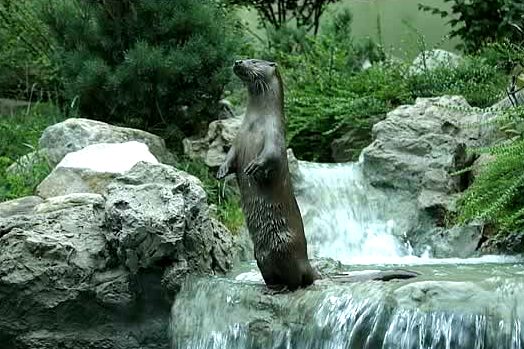|
| Query: river otter | Result: 2nd of 171 | |
Eurasian River Otter (Lutra lutra) - Wiki
| Subject: | Eurasian River Otter (Lutra lutra) - Wiki
| |

| Resolution: 524x349
File Size: 60092 Bytes
Upload Date: 2008:02:22 15:04:05
|
Eurasian otter
From Wikipedia, the free encyclopedia
Order: Carnivora
Family: Mustelidae
Subfamily: Lutrinae
[Photo] Eurasian otter, Lutra lutra, standing at the edge of a waterfall; Svenska: Utter. Pyrénées, Ossau sept 2002. Source: http://en.wikipedia.org/wiki/Image:Loutre_des_pyrenees_ossau_2002.jpg | Permission is granted to copy, distribute and/or modify this document under the terms of the GNU Free Documentation License, Version 1.2 or any later version published by the Free Software Foundation; with no Invariant Sections, no Front-Cover Texts, and no Back-Cover Texts. A copy of the license is included in the section entitled "GNU Free Documentation License". |
The Eurasian otter, Lutra lutra, also known as the Eurasian river otter, common otter, Old World otter and European otter, is a European and Asian member of the Lutrinae or otter subfamily, and is typical of freshwater otters. For the remaining of this article "otter" refers exclusively to the Eurasian otter.
Range and habitat
The Eurasian otter is the most widely distributed otter species, its range including parts of Asia and Africa as well as being spread across Europe. The otter is believed to be currently extinct in Liechtenstein, the Netherlands, and Switzerland. Otters are now very common along the coast of Norway and in Northern Britain, especially Shetland where 12% of the UK breeding population exist. In Italy, they can be found in the Calore river area.
The otter's diet mainly consists of fish but can also include birds, insects, frogs, crustaceans and sometimes small mammals. In general this opportunism means they may inhabit any unpolluted body of freshwater, including lakes, streams, rivers, and ponds, as long as there is good supply of food. Otters may also live along the coast, in salt water, but require regular access to freshwater to clean their fur. When living in the sea individuals of this species are sometimes referred to as "sea otters", but they should not be confused with the true sea otter, a North American species much more strongly adapted to a marine existence.
Behaviour and reproduction
Otters are strongly territorial, living alone for the most part. An individual's territory may vary between about one and forty kilometres long (about half to 25 miles), with about 18 km (about 11 miles) being usual. The length of the territory depends on the density of food available and the width of the water suitable for hunting (it is shorter on coasts, where the available width is much wider, and longer on narrower rivers). The territories are only held against members of the same sex, and so those of males and females may overlap. Males and females will breed at any time of the year, and mating takes place in water. After a gestation period of about 63 days, one to four cubs are born, which remain dependent on the mother for a year. The male plays no direct role in parental care, although the territory of a female with her cubs is usually entirely within that of the male. Hunting mainly takes place at night, while the day is usually spent in the otter's holt (den) – usually a burrow or hollow tree on the riverbank which can sometimes only be entered from under water.
Conservation
The Eurasian otter declined across its range in the second half of the 20th Century primarily due to pollution from pesticides such as organochlorine pesticides (OCs) and polychlorinated biphenyls (PCBs). Other threats included habitat loss and hunting, both legal and illegal Otter populations are now recovering in many parts of Europe for example in Britain the number of sites with an otter presence increased by 55% between 1994 and 2002. Recovery is partly due to a ban on the most harmful pesticides that has been in place across Europe since 1979, partly to improvements in water quality leading to increases in prey populations, and partly to direct legal protection under the European Union Habitats Directive. and national legislation in several European countries. In Hong Kong, it is on a protected species under Wild Animals Protection Ordinance Cap 170. They are listed as Near Threatened by the 2001 IUCN Red List.
Eurasian otters in popular culture
The novel Tarka the Otter, and the film based on it features Eurasian otters. The Redwall series of books by Brian Jacques also regularly features anthropomorphic otters among its characters, even naming one of the books The Pearls of Lutra.
http://en.wikipedia.org/wiki/Eurasian_otter
| The text in this page is based on the copyrighted Wikipedia article shown in above URL. It is used under the GNU Free Documentation License. You may redistribute it, verbatim or modified, providing that you comply with the terms of the GFDL. |
|
Comments |
|---|
| | Guest |
|
| The Eurasian otter, Lutra lutra, also known as the Eurasian river otter, common otter, Old World otter and European otter, is a European and Asian member of the Lutrinae or otter subfamily, and is typical of freshwater otters. |
| | Guest |
|
Scientific Name: Lutra lutra (Linnaeus, 1758)
Common Names:
English – Eurasian Otter, European Otter, European River Otter, Old World Otter, Common Otter
French – Loutre commune, Loutre de rivière, Loutre d'Europe
Spanish – Nutria, Nutria Común
Synonyms:
Lutra nippon Imaizumi & Yoshiyuki, 1989
Viverra lutra Linnaeus, 1758 |
^o^
Animal Pictures Archive for smart phones
^o^
|
|
|